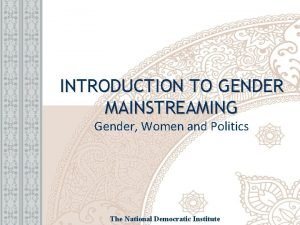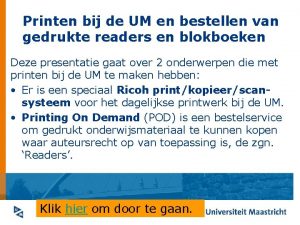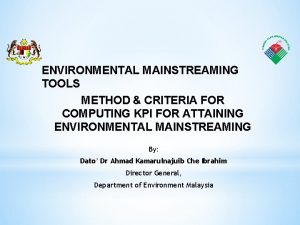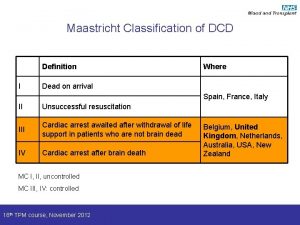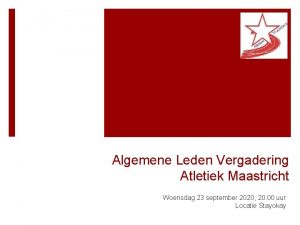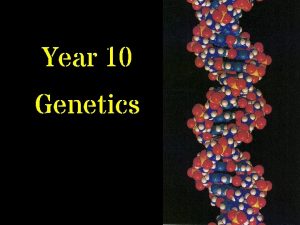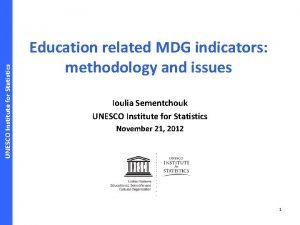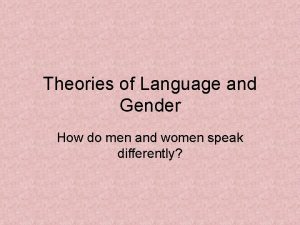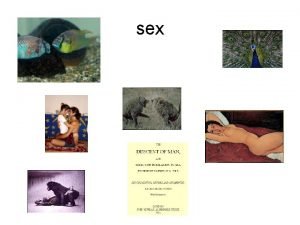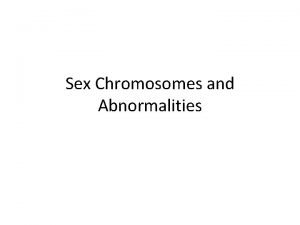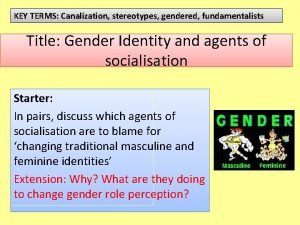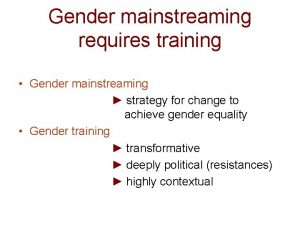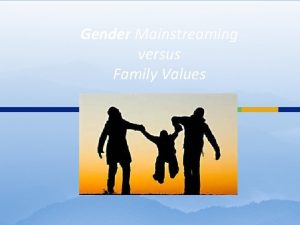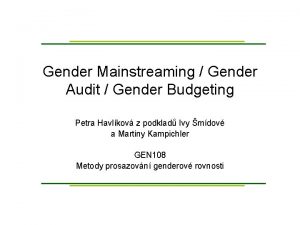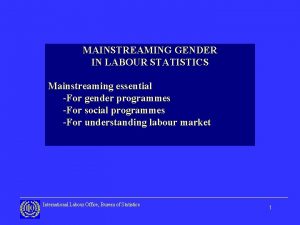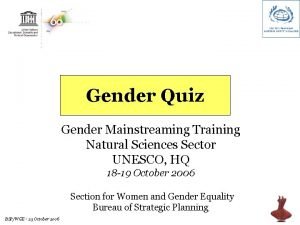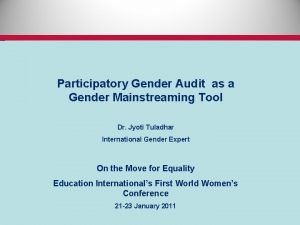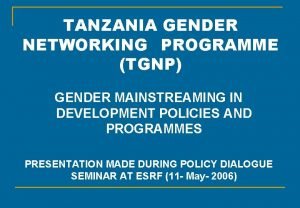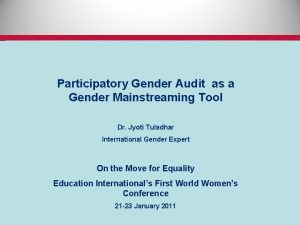Welcome to Maastricht University Mainstreaming a gender dimension






















































- Slides: 54

Welcome to Maastricht University

Mainstreaming a gender dimension into EU research Ineke Klinge Associate professor of Gender Medicine Faculty of Health, Medicine & Life Sciences Department of Health, Ethics & Society Seminar Gender, Research & Innovation, Copenhagen, April 4, 2013 Department 2

Outline lecture • Short overview mainstreaming a gender dimension into EU research • Gendered Innovations Project -biomedicine & health -climate change (? ) • Implementation in Horizon 2020 - necessary steps • Cost Action gender. STE

Mainstreaming a gender dimension in EU research, a summary • Policy framework of gender equality • Gender Impact Assessment studies FP 5 (2000 -2001) • Gender Action Plans of FP 6 (20022006) • Gender. Basic project (2005 -2008) • Gendered Innovations FP 7 (20112012)

FP 7 Expert Group Innovation through Gender 2011 -2012 • Project: Gendered Innovations in Science, Health & Medicine, Engineering and Environment • EU/US collaboration 57 experts involved: from USA, Canada and EU (14 member states) • Presentation of the project in the European Parliament on July 9, 2013 • Website and publication

Gendered Innovations • develops METHODS of sex and gender analysis for research and engineering • provides CASE STUDIES as concrete examples of how sex and gender analysis leads to innovation • www. genderedinnovations. eu


GI Website 6 interactive portals : 1. 2. 3. 4. 5. 6. Methods of sex and gender analysis for research and engineering Case studies illustrate how sex and gender analysis lead to innovation Terms address key concepts used throughout the site. This section serves as a glossary for this project. Checklists for researchers, engineers, and evaluators Policy Recommendations for granting agencies, editorial boards, and institutions in addition to a timeline of national and international policies that support Gendered Innovations Institutional Transformation summarizes current literature on: 1) increasing the numbers of women in science, health & medicine, and engineering; 2) removing subtle gender bias from research institutions; and 3) solutions and best practices

Gendered Innovations Case Studies • Basic Science, Biomedicine & Health (examples) Animal research Stem cells Heart disease Osteoporosis in men Nutrigenomics • Other domains: Communicating science, environment, engineering and technological development, transport

Format of a case study • The challenge • Methods of sex and gender analysis used • Gendered innovations; That is new knowledge or technology produced through application of sex and gender analysis • Conclusion • Next steps for research • Policy recommendations

Animal research • The challenge: basic research is done mostly in male animals

Animal Research II • GI method applied: analyzing sex • Innovative knowledge: Analyzing sex in animal research has led to new knowledge about how hormones influence basic molecular pathways involved in immune system function. When researchers started to use female animals in their research they found that immune function is influenced by the monthly cycle. This is relevant to treating numerous diseases including autoimmune diseases and HIV infection

Stem cell research • The challenge Analyzing sex is rare in animal research and rarer still in cell-based research

Stem cell research • GI method applied: analyzing sex • Innovative knowledge: Research using animal models has shown that the sex of stem cells may influence therapeuticllay-relevant cell traits such as proliferation and differentiation rates

Cardiovascular disease in women • The challenge: CVD as a ‘male’ disease, as a result women are often misand underdiagnosed

Cardiovascular disease in women • GI methods applied: analyzing sex and analyzing gender • Innovative knowledge: analyzing sex has led to understanding that heart disease in women often has a different pathophysiology than men- particularly in younger adults, Analysing sex has led to new diagnostic techniques and better symptomatology. Analyzing gender has led to greater understandings of risk factors and prevention

Osteoporosis research in men • The challenge: Men account for nearly a third of osteoporosis-related hip fractures across Europe and the U. S. Nonetheless, osteoporosis is considered primarily a disease of postmenopausal women, and men are rarely evaluated or treated for it.

Method: Rethinking Standards and Reference Models • Research in many fields—for example, heart disease—has relied on reference models which treat men as the norm. Women are often studied as deviations from that norm. In the case of osteoporosis, however, diagnostic models have been developed for women, using bone mineral density (BMD) norms of healthy young, white women, and criteria to identify risk in men are not well established. • Researchers are improving these reference models and opening new areas of research by considering disease progression in both women and men, and by evaluating risk using sex-specific reference models.

Gendered Innovations I • • Establishing Male Reference Populations: By 1997, evaluation of men's bone quality was based on BMD norms of healthy young men rather than healthy young women More work needs to be done to redefine diagnostic cutoffs for both women and men. Creating New Diagnostics Based on Secondary Contributors to Osteoporosis and Metabolic Bone Disorders; along with variables such as BMD, sex, and lifestyle. Accounting for these factors improves diagnosis in both women and men.

Gendered Innovations II • Analysing gender has enhanced knowledge on gendered behaviours such as tobacco smoking (most common among men) and disordered eating (most common among young women ) can influence bone health • Biologist Anne Fausto-Sterling has described how environment and experience can "shape the very bones that support us. "Osteoporosis is a complex disease that emerges over the lifecycle as a response to "specific lived lives" (Fausto-Sterling, 2008). Correlational studies have shown that women who are more physically active have higher BMDs and stronger bones than age-matched women who are less active.

Nutrigenomics: how sex and gender interact

Nutrigenomics: how sex and gender interact

Gendered Innovations added value Add value to research and engineering by ensuring excellence and quality in outcomes and enhancing sustainability. Add value to society by making research more responsive to social needs. Add value to business by developing new ideas, patents, and technology.

Implementation in Horizon 2020 Policy documents • Horizon 2020 shall ensure the effective promotion of gender equality ad the gender dimension in research and innovation content (art 15) Com (2011) 809 final. • ERA priorities (1/5): gender equality and gender mainstreaming in research COM (2012) 392 final

Implementation in Horizon 2020 Promoting gender equality in research means pursuing three objectives in parallel: 1) improving gender balance in decisionmaking, 2) involving more women as scientists at all levels and 3) integrating the gender dimension in research content. Quote from DG Research Deputy Director at the Gender Summit nov 2012)

Implementation in Horizon 2020 Policy documents (ERA Comm continued) • Member states are invited: To strengthen the gender dimension in research programmes • The Commission will: Foster gender equality and the integration of a gender dimension in Horizon 2020 programmes and projects from inception, through implementation to evaluation, including the use of incentives.

Implementation in Horizon 2020 • The Commission's proposal for Horizon 2020 includes a provision on the commitment to effectively promote gender equality and the integration of the gender dimension in research and innovation content. • This article 15 is a first in the history of European framework programmes. It aims at reinforcing action on gender equality across the different parts of Horizon 2020 will be Europe's biggest ever funding programme for research and innovation, so I hope that its approach to gender will be influential. Statement made by DG Research Deputy Director at the Gender Summit nov 2012

Implementation in Horizon 2020 • Recommendations 2 nd Gender Summit, November 2012: • Create a systematic and standard-driven approach for implementing the Horizon 2020 “gender equality’ article #15 by adding specific operational detail to ensure that gender issues are properly addressed in research proposals their evaluation and impact assessment • All publicly funded research programmes should require applicants to address the role of gender dimension in their proposals for evaluation and across the whole research process

Implementation in Horizon 2020 • Grand societal challenges • Health, demographic change and wellbeing; • Food security, sustainable agriculture, marine and maritime research and the bio-economy; • Secure, clean and efficient energy; • Smart, green and integrated transport; • Climate action, resource efficiency and raw materials; • Inclusive, innovative and secure societies.

Implementation in Horizon 2020 necessary steps Innovation lies at the heart of the Europe 2020 strategy, and the Innovation Union aims at making Europe a global leader in solving societal challenges. Excellent research and innovation therefore takes into account women’s and men’s needs, behaviors and attitudes by employing methods of sex and gender analysis.

Stakeholders: Researchers Realizing the full potential of Gendered Innovations in the next decade will require that this expertise be brought into the research process, either by scientists and engineers learning the methods of sex and gender analysis relevant to their work, or by experts in gender analysis joining a research team. The current generation of researchers needs to learn how to exploit the creative power of sex and gender analysis in their research design.

Stakeholders: Granting Agencies Proposal Requirements. The European Union can retain its leadership in Horizon 2020 by again asking that applicants explain how sex and gender analysis is relevant to the concepts and objectives of the proposed research. Researchers could also demonstrate that sex and gender are not relevant to a particular project. It is important, however, that the issue is explored and becomes an integral part of the proposals to be evaluated. Proposal Evaluation. Evaluators should to be trained to carry out gender reviews of proposals, using a template with a checklist, particularly for those dealing with humans as either subjects or users.

Stakeholders: research institutions Hiring and promotion committees can evaluate researchers and educators on their success in implementing gender analysis. Knowledge and use of methods of sex and gender analysis can be one factor taken into consideration in hiring and promotion decisions.

Stakeholders: Editors of Peer-Reviewed Journals Editorial boards can require sophisticated use of sex and gender methodology when selecting papers for publication. A number of journals do so for instance, Nature, the Journal of the American College of Cardiology, and the Canadian Medical Association Journals should also enforce consistent use of keywords such as “sex” and “gender” to facilitate meta-analysis.

Stakeholders: Industry • Inventions that incorporate the smartest aspects of gender can open new markets and enable innovation in products, processes, services, or infrastructures. Gender expertise—whether developed internally or brought in by consultants— can help industry identify new markets, develop technologies, and bring new ideas to market. Products that meet the needs of complex and diverse user groups enhance global competitiveness and sustainability.

Stakeholders: the Next Generation • Sex and gender analysis should be integrated into high school and university curricula, including basic science, medicine, and engineering courses. Textbooks should be revised to integrate sex and gender results and methods.

Dissemination Gendered Innovations • Session at the European Parliament, July 9, publication • Cost Action gender. STE 2012 -2016 • Proposal preparing the future for health research and innovation (EUGENMED), FP 7 Health Call 2012, second stage

COST Action gender. STE 2012 -2016 • gender. STE is a new COST initiative to advance the state of the art in knowledge and policy implementation on gender, science, technology and engineering through creating a network of policy-makers and experts on gender, science and technology. • http: //www. cost. eu/about_cost/governance /genderste

COST Action gender. STE 2012 -2016 Specifically it will enhance the implementation of gender-focused policy measures for structural change in science and technology institutions and integration of sex and gender dimensions in the content of science and technology. It aims to develop knowledge and resources regarding the sex and gender dimensions of technological development and innovation processes, with specific attention to the Grand Challenges identified in Horizon 2020 and the Joint Programming Initiative (JPI) Urban Europe.

COST Action gender. STE 2012 -2016 Aim (1/3) of the action: Promoting a better integration of gender in the content of science, research and technology, by dissemination existing research on the topic, i. e. the EU-US Gendered Innovations project

COST Action gender. STE 2012 -2016 Activities: • Presentations at major science policy conferences • Training workshops for representatives of science policy and science funding organizations (focus on biomedicine & health) • Targeted information sessions in institutions in COST and Near Neighbor countries • Exchanging information/ providing training to Action participants from countries that are less advanced in this area

Reading suggestions • Linda Nieuwenhoven & Ineke Klinge(2010) Scientific Excellence in Applying Sex- and Gender-Sensitive Methods in Biomedical and Health Research Journal of Women's Health. February 2010, 19(2): 313 -321. • Klinge, Ineke (ed)(2007). Gender. Basic: Promoting Integration of Sex and Gender Aspects in Biomedical and Health-Related Research. Gender Medicine. 4(Supplement B), S 59 -S 178. • Ineke Klinge & Claudia Wiesemann (eds) Sex and Gender In Biomedicine. Theories, Methodologies, Results. Universitätsverlag Göttingen 2010. ISBN 978 -3 -941875 -26 -5 • Londa Schiebinger & Ineke Klinge (eds) Meta-analysis of gender and science research-Topic Report Mainstreaming sex and gender analysis into research, http: //www. genderandscience. org/doc/TR 6_Content. pdf • Schiebinger, L. , Klinge, I. , Sánchez de Madariaga, I. , and Schraudner, M. , eds. (2011 -2013). Gendered Innovations in Science, Health & Medicine, Engineering, and Environment www. genderedinnovations. eu.

Thank you for your attention

Gender Medicine • Recognition that sex and gender affect the health of women and men • Sex refers to biological differences • Gender refers to cultural and social attitudes that together shape ‘feminine’ and masculine’ behaviour • Interaction between sex and gender leads to different manifestations of frequent diseases

Why Gendered Innovations? • Sex and gender bias in research extensively documented (Meta-analysis of Gender & Science Research, 2011) • Is expensive in terms of lives and cost • Limits the excellence of research and hence the potential benefits to society

Business case public health • Science (26 -03 -2010): Between 1997 and 2000, 10 drugs were withdrawn from the U. S. market because of lifethreatening health effects. Eight of these caused a greater number of adverse reactions in women (U. S. GAO, 2001).

Most research is done in males

CREDIT: ADAPTED FROM ANNALIESE K. BEERY AND IRVING ZUCKER. Cited in Wald, C. & Wu, C. (2010). Of Mice and Women: The Bias in Animal Models. Science 327: 1571 -1572.

IT’S NOT ENOUGH TO IDENTIFY BIAS We need to DESIGN research correctly from the beginning

Developing methods • Started with definition of terms such as sex, gender, male, female, women, race & ethnicity, stereotypes, masculinity, femininity,


Sex and gender interact • Sex and gender are analytically distinct but not independent. They interact in important and complex ways: “Not only can gender relations influence expression and interpretation of biological traits, but also sex-linked biological characteristics can, in some cases, contribute to or amplify gender differentials in health” (Krieger, 2003) • Sex and gender are distinct terms, yet they interact in important ways. Rarely does an observed sex difference involve only sex and not gender, and rarely does gender analysis operate outside of the context of sex (Krieger, 2003). Apparent sex differences may be caused by gendered variables, such as social divisions of labor. Analyzing gender should accompany analyzing sex.

Analyzing factors intersecting with sex and gender: These factors or variables can be biological, socio-cultural, psychological, etc. aspects of users, customers, experimental subjects, cells, etc. These factors include but are not limited to: ●Genetics ●Age ●Sex Hormones ●Reproductive Status ●Body Composition ●Co-morbidities ●Body Size ●Disabilities ●Ethnicity ●Nationality ●Geographic Location ●Socioeconomic Status ●Educational Background ●Sexual Orientation ●Religion ●Lifestyle ●Language ●Family Configuration

 What is gender mainstreaming?
What is gender mainstreaming? What is gender mainstreaming?
What is gender mainstreaming? Sex videao
Sex videao Gender mainstreaming
Gender mainstreaming Maastricht university economics and business economics
Maastricht university economics and business economics Maastricht university supply chain management
Maastricht university supply chain management Admission maastricht university
Admission maastricht university Print um
Print um Maastricht university ib
Maastricht university ib Canon maastricht university
Canon maastricht university Protection mainstreaming principles
Protection mainstreaming principles Epmc doe
Epmc doe Mainstreaming in swahili
Mainstreaming in swahili Strategic gender needs and practical gender needs
Strategic gender needs and practical gender needs Gender dimension examples
Gender dimension examples Maastricht convergence criteria
Maastricht convergence criteria Paog maastricht
Paog maastricht Maastricht classification
Maastricht classification Fietsenstalling kesselskade
Fietsenstalling kesselskade Faculty of law maastricht
Faculty of law maastricht Dcd maastricht classification
Dcd maastricht classification Maastricht
Maastricht Selexyz dominicanen bookstore
Selexyz dominicanen bookstore 23 september maastricht
23 september maastricht Po dd
Po dd Consenso de maastricht
Consenso de maastricht Video platform huisartsopleiding
Video platform huisartsopleiding Welcome welcome this is our christmas story
Welcome welcome this is our christmas story Shivaji university student login
Shivaji university student login Columbia university school of nursing
Columbia university school of nursing Mygrants columbia
Mygrants columbia 詹景裕
詹景裕 Punnett square xy
Punnett square xy Xxy gender
Xxy gender Gender action plan world bank
Gender action plan world bank Gender action plan world bank
Gender action plan world bank Compare and contrast wid and wad
Compare and contrast wid and wad Define gender parity
Define gender parity George keith and john shuttleworth
George keith and john shuttleworth Slidetodoc.com
Slidetodoc.com Define gender constancy
Define gender constancy Socialization is a lifelong process meaning
Socialization is a lifelong process meaning Gender definition
Gender definition Snow white 1812
Snow white 1812 Xxy chromosome gender
Xxy chromosome gender Sex chromosome aneuploidy
Sex chromosome aneuploidy Gender-neutral housing pros and cons
Gender-neutral housing pros and cons Moser framework tools
Moser framework tools Is there any bias in gender roles based on the excerpt
Is there any bias in gender roles based on the excerpt The pedigree traces red-green color blindness
The pedigree traces red-green color blindness Paradigm shift from women studies to gender studies
Paradigm shift from women studies to gender studies Mbti by gender
Mbti by gender Canalization gender examples
Canalization gender examples Performative acts and gender constitution judith butler
Performative acts and gender constitution judith butler Feminist criticism definition
Feminist criticism definition
